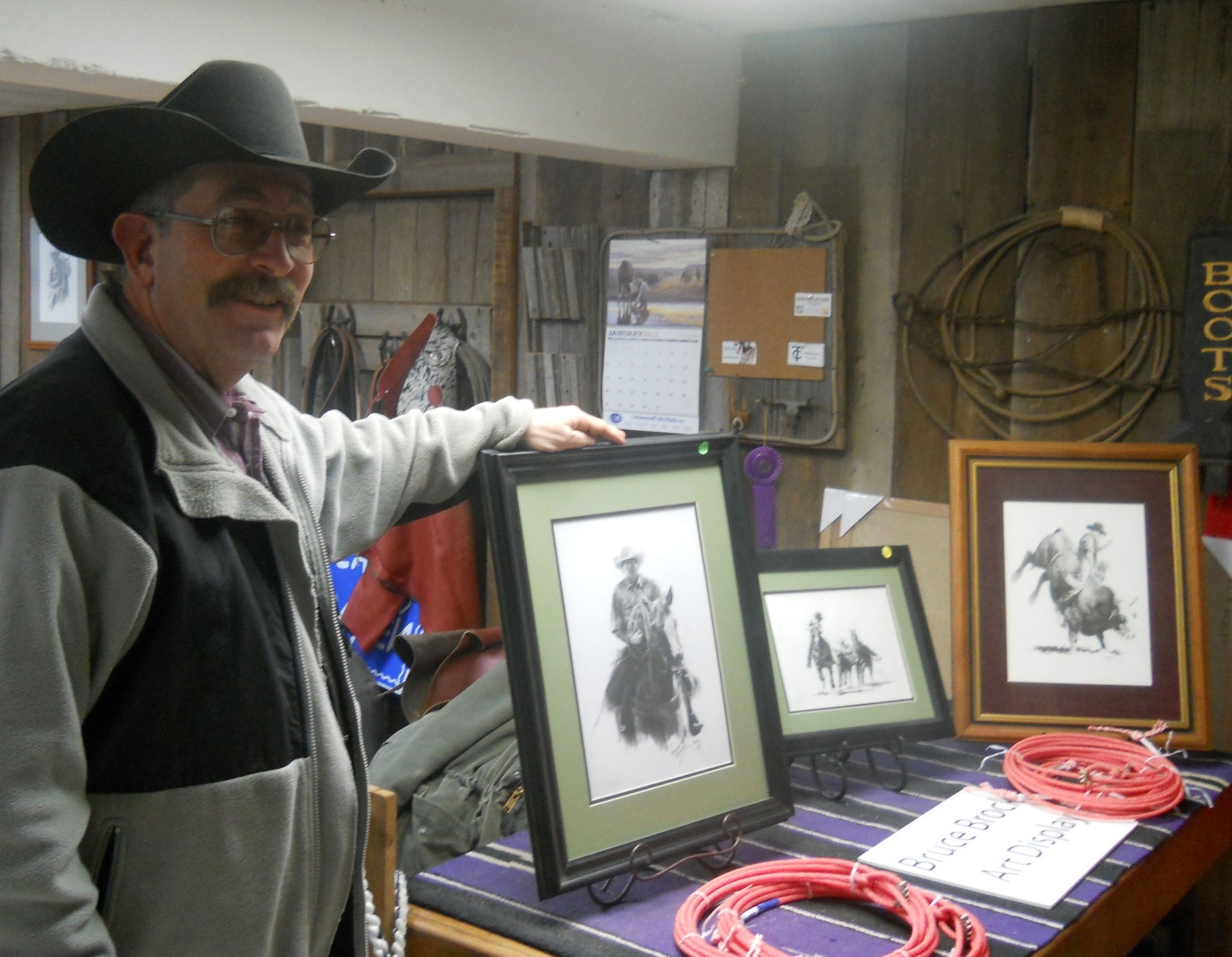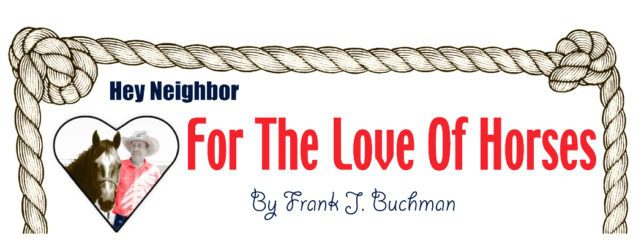This cowboy is an architect.
Well, that could be a stretch of the definition one generally thinks, although he has designed structures and has built homes.
However, Bruce Brock truly is a designer in every sense of delineation.

He makes and repairs cowboy equipment, draws and paints with a unique Western flare and writes cowboy poetry.
“I really do a little bit of everything, but it all relates somehow to being a cowboy, and the experiences I’ve had, and live all the time,” insisted Brock, at his leather shop in the Jim Bell and Son Western Store, Cottonwood Falls.
“I spend a lot of time on horseback looking after cattle and helping ranchers; then come work here,” continued Brock, who keeps regular winter shop time.
“As demand for my work has expanded, I have to put in long hours to keep up in the spring when cattle are going to grass, and gathering in the summer,” the cowboy-craftsman contended.
Those busy days all expand his repertoire.
Raised the son of a Chanute carpenter, Brock contended, “I always dreamed of being a cowboy, rode horses, showed them and cattle in 4-H. But, I enjoyed drawing horses and cattle, too, like my Grandpa (Art ) Coonrod, frequently was doing. So, everything has kind of come together.”
Assisting his dad’s carpentry during high school, where he excelled in art, Brock attended Neosho County Junior College. “I considered architecture, but graduated with a general degree, heavy in art classes,” he said.
“Cowboy Life of the True West” called, and Brock moved to Colorado. “I worked seven years for the 80,000-acre Cage Ranch,” he related.
It’s a cow-calf and steer operation with large pastures. “That was a truly a great experience,” Brock admitted. “There was horseback work, but a 14-section pasture was gathered with a helicopter.
“I did sketching and art while there, and I got into repairing and making horse equipment,” he continued. “I even built a saddle, the first one I’d made, from scraps left at my place by a friend.”
Then, the cowboy-craftsman was instinctively drawn back to his beloved Flint Hills. “I worked for Elmore Stout at his TS Herefords and Quarter Horse Ranch and learned more about working with cattle and horses,” Brock reflected.
Again, art was his pacifying sideline, but when neighboring cowboys learned of his leather skills, there was soon demand for that work. “I had a small leather shop on the ranch,” Brock noted.
Yet, a homebody, the cowboy returned to help his dad, Merrill, in home construction for a period. “Some people don’t like working with their parents, but I always enjoyed that,” contended Brock, who continued leather work.
“I kept getting calls from ranchers around here to repair and make equipment. Randy Peterson at the Buck Creek Ranch suggested I come back and set up shop,” Brock said.
In 1996, Brock moved to his present location. “I thought I ought to have something to support it, so I learned the boot repair business, and bought equipment for that, too,” he related.
Business was soon booming. “I do all kinds of leather repair, make lots of chaps and chinks, about anything a cowboy needs. I’ve made ten saddles, but I’d rather repair them due to lack of time,” Brock said.
With leather business, often featuring intricate tooling, so demanding, Brock becomes pinched for artwork time. “I do a lot of my drawing and painting at home in the evenings,” admitted Brock, who has his buckskin gelding, Buckwheat, and sorrel mare, Agnes, at his place on the south edge of town.
While pencil and pen-and-ink sketches of working cowboys, rodeo action and Flint Hills’ life might be considered his forte, Brock said, “I do watercolors, charcoal, pastels, chalk, whatever somebody wants, or I get the urge to do.”
An original requires a minimum of 12 hours to complete, and Brock’s work has been so popular, there is generally demand for multiple prints. “I do a couple dozen pieces a year, mostly commissions. I’ve done several for the Symphony in the Flint Hills,” Brock said.
Always looking for a niche, Brock has had his art laser-printed on leather money clips, cup holders, phone cases, etc., as well as Christmas and note cards.
“They’ve been extremely popular, but things are faddish, so I keep coming up with something new,” Brock contended.
That now includes cowboy poetry. “I just got the urge to write, it seemed to flow, and others apparently like what I’m doing,” Brock revealed. “I don’t have my poetry memorized, so I read it at the Emma Chase Café and other gatherings.”
“My goal is to publish a book of my cowboy poetry portrayed with my artwork,” Brock envisioned.
Yep, this cowboy is an architect of leather, art, poetry, all relating to the Flint Hills way of life.
